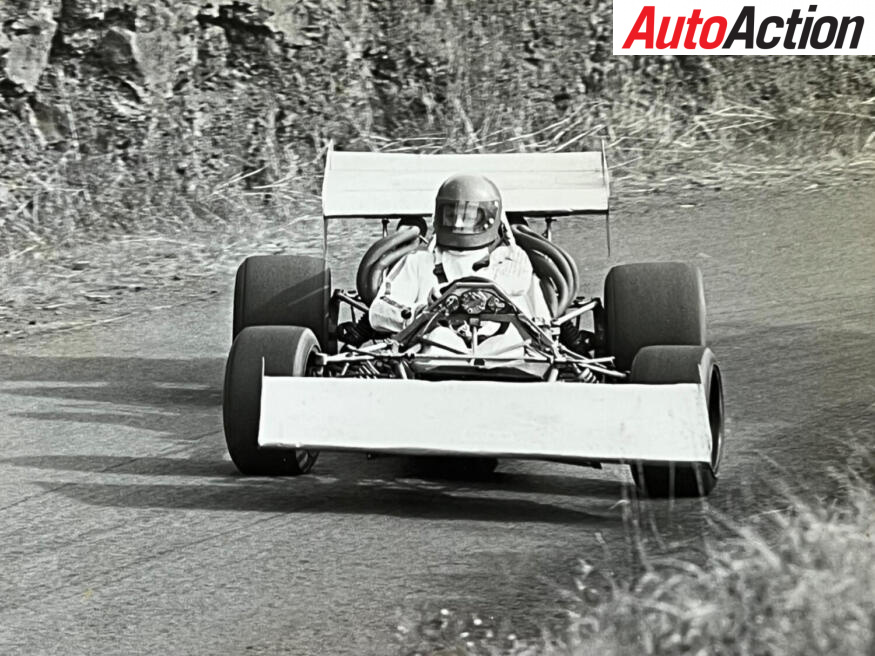When monsters roamed the mountains

The eerie, still morning mist over Mount Tarrengower, Maldon, Victoria was interrupted by the harsh, exotic sound of a Repco 4.4-litre 620 V8 as Peter Holinger blipped the throttle of his Holinger Repco before popping the clutch at high revs.
You could hear the engine note rise and fall in the distance as Holinger played with the laws of physics, balancing the throttle and grip of his cold tyres as he made his way up this open hill, blasting past our marshalling point at warp-speed…
There is nothing like the mix of a bucolic environment and high-tech in motorsport that’s provided by hillclimbing.
READ THE FULL FEATURE IN THE LATEST ISSUE OF AUTO ACTION HERE

Paul England blasts the Ausca-VW S/C, twin supercharged VW engined-four-wheel-drive monster to Australian Championship victory in 1973 at Lakeland … Image: AUTO ACTION
In the 1950s and 1960s, even into the 1970s, huge crowds attended hillclimbs which were sometimes televised. The cars were the best-of-the-best touring cars, sportscars and open-wheelers of the time.
Beechey, Bond, Brock, Firth, Jane, Manton, even The Captain Peter Janson in his A9X Torana very late into the seventies, thrilled the crowds at close quarters with their car control.
Gradually, as circuit numbers and race-meetings grew, attendance on the hills slipped away, but the excitement and spectacle is still there if you take the time to seek it out.

Paul England’s Ausca VW, twin engined, four-wheel-drive-with body on … a championship winner. Image: Mike Jacobson
The seventies was a Hillclimbing Golden Era. Between 1970 and 1979 eight cylinders dominated the Australian Hillclimb Championship (AHC), only the Flat Six fitted to Alan Hamilton’s Porsche 906 sports-prototype at Collingrove in 1971 bucked the trend.
1-I’m playing with words a bit…because the Ausca VW built and raced by gun-engineer and proprietor of Paul England Engineering in Melbourne, Paul England, used two VW flat-fours, the rear of which was supercharged with the mixture being fed to the combustion chambers of both the front 1.6-litre, and rear 2-litre mounted engines.
The original thinking within the SWB, spaceframe chassis, extended to four-wheel-drive. Each engine had its own two-speed gearbox – ‘fast and faster’ as Paul always put it – which drove a pair of wheels at each end. The body, when he ran it, was a modified Geneer Formula Vee fibreglass panel.
This ingenious device won at Mount Cotton in 1970 as well as the much more demanding four-round-titles held on a variety of courses in 1973 and 1974.

Ian Judd’s Cheetah Mk4 – yet another ‘Olds-powered’ car, at the Mount Leura ‘climb.’ Image: GREG STANSFIELD
Peter Holinger was the other dominant seventies driver, winning AHCs in 1976 and 1978-79 at Bathurst, Collingrove and Mount Cotton respectively.
READ THE FULL FEATURE IN THE LATEST ISSUE OF AUTO ACTION HERE
England and Holinger lived close together in Melbourne’s leafy outer-eastern fringe and both oh-so-talented-engineers and elite level drivers did their time at Repco; Repco Research in Brunswick for Paul, and the Engine Division and Repco Brabham Engines in Richmond for Peter.
England’s ‘homer’ built after hours at ‘Research was the Ausca Repco-Holden Hi-power, an exotic sportscar that proved the pace of Repco’s new Charlie Dean/Phil Irving designed Hi-power crossflow head, putting many single-seaters to shame.
England then did a spot of racing in Europe in an F2 Cooper T41 Climax including the 1957 German Grand Prix on the Green Hell, the Nurburgring before returning home to establish his business.

Murray Bingham’s Cobra typified the wild range of cars contesting hillclimbs in the early 1970s. Image: GRAHAME LOGG
The 4.4-litre engine in Holinger’s car is engine E1, the very first RBE V8 ever built. Peter machined and assembled the parts for the then 2.5-litre V8 under the watchful eye of its designer Phil Irving, who like him, lived in Warrandyte. They fired it up for the first time on March 19, 1965. Three F1 drivers and manufacturers championships followed…
The Holinger chassis is a copy of Brabham BT31-1 Repco, Jack Brabham’s 1969 Tasman mount. When Rodway Wolfe bought BT31 from Repco, his good mate Holinger stored it for a while.
The quid-pro-quo was Rod’s agreement to allow Peter to copy the car as the basis of a machine to succeed the Holinger Vincent Peter had campaigned since the mid-1960s.B2
Its engine was trick in that the cams were grinds which provided bulk-torque rather than a more-peaky top-end. For a while it raced with a single-BRM-like transmission mounted brake rotor and caliper sourced from a Renault R8.
READ THE LATEST ISSUE OF AUTO ACTION HERE
Don’t forget the print edition of Auto Action available via subscription here. For more of the latest motorsport news, subscribe to AUTO ACTION magazine.






